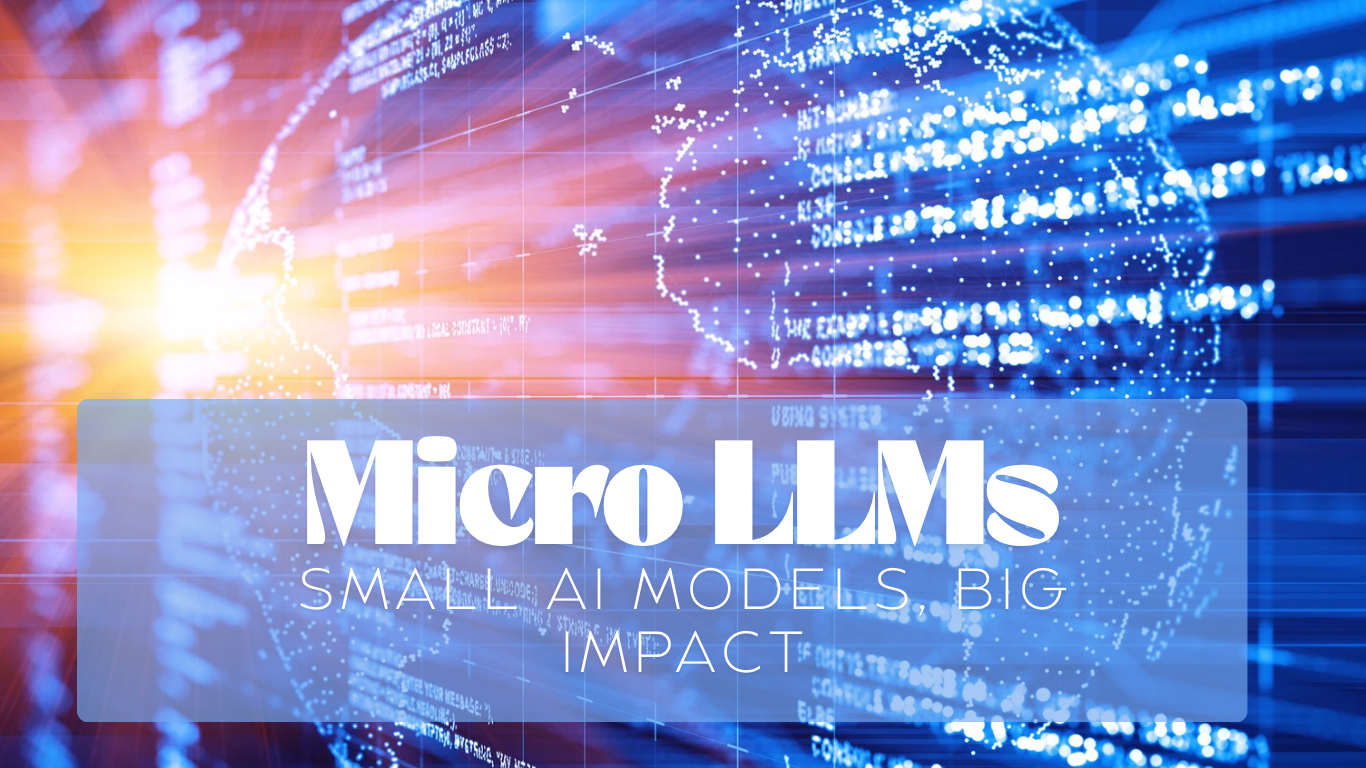Introduction: The Rise of Micro LLMs
With Large Language Models (LLMs) like GPT, BERT, and PaLM grabbing headlines, artificial intelligence (AI) has progressed significantly in the past few years. Yet today, the computer community is talking about Micro LLMs, that are microscopic yet highly powerful. These condensed language model versions offer effective, high-performance solutions without the burdensome computational load. Consider them the “smartphones” of artificial intelligence; they are lighter, more compact, and have incredible capabilities.
Micro LLMs are becoming a revolutionary development in the field of artificial intelligence because of the growing demand for privacy, speed, edge computing, and sustainability. We examine the definition of Micro LLMs, their advantages, their effects on various businesses, and their prospects in this blog.
What Are Micro LLMs?
Micro LLMs are smaller, lighter versions of large language models. They work on devices with limited resources, like mobile phones and edge servers. Standard LLMs, like GPT-4, are much larger and need powerful GPUs or cloud computing.
Usually, they have the following:
~ Reduced parameters (millions as opposed to billions)
~ Reduced memory footprints
~ Quicker inference time
~ Minimal hardware needs
Micro LLMs like TinyLlama, DistilBERT, LLaMA 2 7B with quantization, Phi-2 by Microsoft, and Mistral-7B with LoRA tuning are some examples.
Why Micro LLMs Matter: Key Benefits
Resource Efficiency:
Micro LLMs, operating on CPUs or smaller GPUs, offer energy efficiency, lower infrastructure costs, and excellent scalability for SMEs and startups.
Real-Time Processing on Edge Devices:
Micro LLMs enable quicker reaction times, offline functionality, and lower bandwidth consumption by locally completing operations like language translation, speech recognition, and summarization.
Enhanced Privacy:
Since micro LLMs operate on-device, they improve user privacy and are crucial for use cases in government and defense, healthcare, banking, and legal technology.
Accessibility and Democratization:
Compact, open-source models allow academics, developers, businesses, and students to experiment with AI, integrate in low-resource areas, and gain knowledge without expensive GPUs.
Better for the Environment (Green AI):
Micro LLMs use less energy. They are a more sustainable alternative for widespread use. This addresses concern about AI’s environmental impact.
Where Micro LLMs Are Making Waves
Healthcare :
Real-time transcription of patient notes, on-device diagnostics in remote clinics, and symptom checking without internet dependency are some of the innovative technologies being implemented.
Finance :
Micro LLMs are gaining popularity in finance, offering automated customer support bots on mobile apps, risk analysis and fraud detection, and real-time personalized financial advice.
Retail and E-commerce :
Micro LLMs are popular in retail and e-commerce. They power voice-activated shopping. Micro LLMs enable smart inventory management. They also provide multilingual customer support.
Education :
AI tutors on tablets are being used for underprivileged students, while personalized learning tools and localized language support are being implemented in rural areas.
Smart Devices :
Smart devices, including AI-powered wearables and home automation, are revolutionizing the way we communicate and control our homes and appliances without relying on cloud services.
Micro LLMs vs. Large LLMs: A Quick Comparison

Challenges & Limitations
Micro LLMs aren’t perfect; they’re not very good at much, aren’t always accurate, are hard to train, and could be insecure. They’re great at certain tasks, but optimizing them is tough unless you have huge datasets. Luckily, research on quantization and training is helping with these issues.
Micro LLMs: Game-Changer for Businesses Across Industries
Micro LLMs enable companies to provide intelligent, quick, private, and economical AI experiences without requiring a large infrastructure. Adopting this tiny AI revolution could result in faster innovation and a significant competitive advantage for businesses of all sizes.
Micro LLMs are a game changer, working even on weak tech. These compact models are making AI quicker, cheaper, and more private in tons of industries—from healthcare to retail—with no need to rely so much on the cloud. Businesses win with happier customers, lower bills, and better data security. As micro LLMs continue to evolve, they are set to become a cornerstone of smart, scalable, and localized digital transformation across sectors.
The Future of Micro LLMs: What Lies Ahead
Micro LLMs (micro large language models) have a bright future ahead of them; in fact, they are revolutionary. With a growing demand for intelligent, private, and real-time AI interactions, Micro LLMs are poised to play a major role in ubiquitous computing.
Ubiquity Across Edge Devices:
Micro LLMs will soon be found in a wide range of devices, including TVs, vehicles, AR/VR equipment, smartwatches, and Internet of Things sensors. They won’t require extensive cloud backends or continuous internet connectivity to function independently.
Imagine requesting cooking suggestions from your refrigerator or having your smartwatch compile your emails without transferring any data to the cloud.
Enhanced Data Privacy and Control:
Users will have more control over their personal data when AI operates locally. This change is entirely in line with laws like GDPR and HIPAA as well as the growing global concerns about digital privacy.
A new era of “private-by-design” apps and gadgets will soon be fueled by micro LLMs.
Decentralized AI Ecosystems:
The emergence of Micro LLMs will decentralize AI, shifting it away from centralized data centers and toward distributed edge environments. This will enable AI access even in areas with poor bandwidth or no connectivity, lower latency, and increased scalability.
This is revolutionary for remote healthcare, agricultural technology, and rural education.
Tailored and Personalized Models:
Future Micro LLMs will become fine-tuned for certain tasks or user profiles, providing hyper-personalized services such as a personal therapist on your phone or a financial advisor that adapts to your lifestyle.
Consider an AI that grows on your device beside you.
Energy-Efficient and Eco-Friendly AI:
As these models get more sophisticated and lightweight, they will demand less processing power, lowering the carbon footprints associated with cloud AI computing. Greener tech products that are AI-enabled and energy-efficient are to be expected.
New Business Models and App Ecosystems:
Applications and platforms designed especially for Micro LLMs will proliferate, providing real-time AI capabilities in fields such as field operations, sales, customer service, and content production.
It will be quicker, less expensive, and easier for entrepreneurs to innovate.

Final Thoughts
In an era where “bigger is better” has long been the slogan in technology, micro LLMs defy the standard. They demonstrate that intelligent design, optimization, and focus can outperform brute computational power. As industries seek speed, efficiency, and security, the Micro LLM wave will only get stronger.
So, whether you’re a startup founder, developer, educator, or simply interested in the future of AI, Micro LLMs are worth watching, learning from, and building with.



